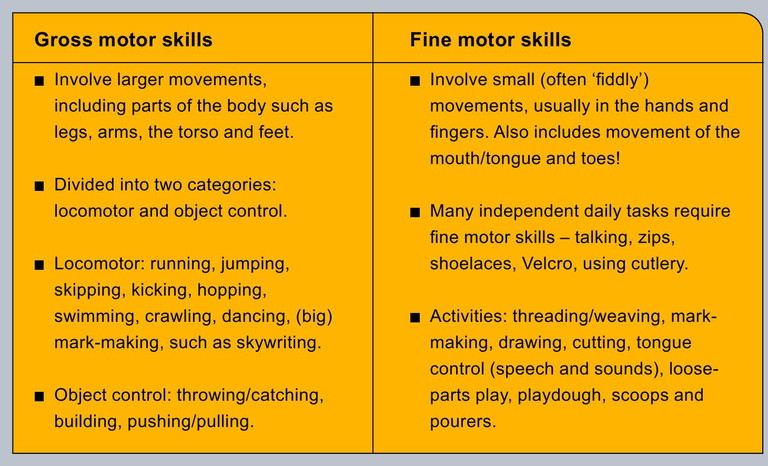BEST PRACTICE
Gross motor vs fine motor skills
We take a closer look at the difference between gross motor skills and fine motor skills in little ones, and how to develop both effectively
When new to the early years – whether new families or new team members – we often find that the gamut of new information and terminology can be overwhelming.
Because daily use means educators are familiar with certain terms, it’s easy to forget that for many, a lot of this phrasing is new and, quite possibly, gobbledegook!
So, we’re giving an overview into the types of skills essential to early development and learning, and the activities and play that can help hone these skills.
Motor skills are talked about daily in early years circles, referring to the muscle movements we make in our everyday lives to perform tasks. Depending on the groups of muscles used, they can be classed as fine motor or gross motor.
The Early Years Foundation Stage (EYFS) Statutory Framework says: “Gross and fine motor experiences develop incrementally throughout early childhood, starting with sensory explorations and the development of a child’s strength, co-ordination and positional awareness through tummy time, crawling and play movement with both objects and adults.”
Both skill types are related, yet research has identified that boys, on the whole, struggle more with fine motor skills than girls while a slightly larger number of girls struggle with gross motor skills.

Activity suggestions
Please ensure that, for each activity, an appropriate risk assessment has been undertaken to ensure the safety of all children taking part in activities.
Fine motor skills
Mouth moves
Blowing bubbles
Songs and nursery rhymes with repetition and onomatopoeia
Tracing shapes/air writing with tongue
Threading beads
For very young children, something solid like a straw or pipe-cleaner will help, as will chunky ‘beads’ such as pasta tubes or cotton reels. Older children could use thick yet flexible thread such as new shoelaces or garden twine with smaller beads.
Good for: pincer grip, hand/eye coordination.
Playdough
Make the dough using heat-treated flour according to FSA guidelines (see pages 24-25). It’s a good warmup, with plenty of mixing and stirring. Once made, the dough can be used for a multitude of activities, and it is great for developing fine motor skills as it is constantly working those little muscles of the hands. Supply some extras and watch the fun unfold: bun cases and birthday candles; some sticks, pebbles, shells and leaves; plastic animals; some rolling pins and cutting wheels; a potato ricer; paper plates and herbs; toy cars; old food packets and boxes. As you can see, the possibilities are endless.
Good for: strengthening all the muscles of the fingers, hands and wrists.
Clothes line
Hang a length of string low enough for children to reach, but below neck height for safety, and give them a number of light items – dolls clothes, socks, tea towels – to hang up, plus a basket of pegs. Demonstrate how
Good for: hand/eye coordination, pincer grip
Sewing
This can be as basic or as advanced as necessary. For basic level ‘sewing’, use broad ribbons to thread in and out of a hole-punched card. Tie knots for easy-to-grip ribbons.
Another option is weaving with ribbons through fencing or netting outside!
Felt is good for more advanced sewing projects, too, although it can be difficult for a little one to push a needle through layers of felt.
Good for: pincer grip, hand/eye coordination.
Gross motor skills
Move in different ways
Make sure there are plenty of opportunities (indoors and outdoors) for children to use a full range of body movements, for example climbing over and up structures, balancing, crawling through tunnels, swinging themselves by the arms, hopping, running, twisting, crouching etc…
Splashing and puddles
Young children love puddles and can have plenty of fun outdoors if dressed in waterproofs and suitable boots. Challenge them by suggesting different ways of moving – hopping in the puddles, skipping etc. to test out different muscle groups and build control
Indoor movements
If it’s not possible to get outside where there’s more space, there are still plenty of activities that can help little ones moving indoors. Why not try playing ‘keep it up’ with a balloon? Or playing catch with a bean bag?
Structural mayhem
Build an obstacle course together with items around you – think about different levels/ heights, types of movements to complete different elements.
Construct a den: how tall does it need to be, what items around us can we use, how do we make sure it stays up? There’s lots of scope for problem-solving and expanding spatial awareness here.
A splash of mud
Use tree trunks and wet mud to create mud portraits or pictures: talk about what you can find to use for different features (grass or twigs for hair, pebbles or conkers for eyes), use language of shape to discuss each other’s features.
Have a go at creating some natural ‘paint’ from things you can see, like berries, leaves, loose flower petals – how many different colours can you make? What items can be used to mix?
Family Corner
Follow the links below to find more information about activities to develop both gross and fine motor skills in fun yet simple ways: